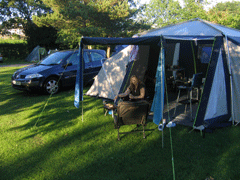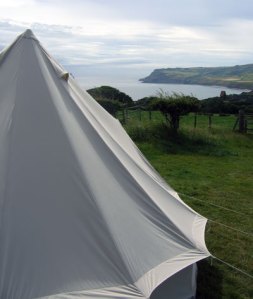I’ve got a problem. It’s taken me a while to realise, admittedly, but at least I’ve taken ownership of it now… I’ve metaphorically attended the AA meeting and ‘fessed up.
Some people are addicted to nicotine, some to alcohol, some to sex, some, even, to classic BMXs. I’m addicted to tents. How badly? Well, I have some measure of this failing in that I don’t own too many.
I saw them all stacked in the garage in their stuff sacs and counted five, including my bivvy bag.
All of them have different uses and I cling onto these applications to justify the purchases…
 Sunncamp APS 3004 (no longer available): The family tent, even though there are only two of us. This four- man had the immediate appeal of being able to park our car in the living area – although we haven’t tried it – and having enough headroom for me.
Sunncamp APS 3004 (no longer available): The family tent, even though there are only two of us. This four- man had the immediate appeal of being able to park our car in the living area – although we haven’t tried it – and having enough headroom for me.
For such a large tent, the external frame of this monster and heavy material means it’s pretty sturdy, having withstood some hefty storms in its life.
I picked it up for £180 about five years ago and it’s been a faithful servant. It has its problems: a flappy door, poor ventilation, almost non existent bug protection but the other half and I have spent many a happy night in it.
Vango Equinox 450: This is my car camping tent, when I’m looking to escape to the Lakes for a few days and can’t justify big bertha.
 It’s pretty big, really, and quite storm proof as it’s a tunnel bolstered by Vango’s APS bracing straps.
It’s pretty big, really, and quite storm proof as it’s a tunnel bolstered by Vango’s APS bracing straps.
I spent the coldest night I’ve ever camped out in this tent. I was at the Langdale campsite in November and stable high pressure had gripped the north.
The days were clear, the nights freezing.I woke up to ice on the inside of the tent and warden informed me that the temperature had plummeted to –10 deg Celsius during the night. Before I got out of my warm sleeping bag, a couple had walked by the tent and wondered, aloud, if ‘someone was alive in there’.
Bug protection is good on this tent and it’s going to be home for a jaunt to Scotland next month.
North Face Westwind: This is a classic Himalayan tent, which has been around for years. It’s very well made and tough as old boots.
I bought it, perhaps naively, as a backpacking tent as it the inner is long enough to house my cumbersome frame. It’s relatively heavy and bulky, and a few trips lugging it around soon convinced me that I needed something lighter.
It does get used, though, and I know I can rely on it for winter trips.
Hilleberg Akto: My backpacking tent, and I love it for a whole range of reasons outlined in other posts on this site.
 I’ve got one problem with it at the moment, though. The black fabric at the ends of the tent, where the vents are located, is starting to pull at the stitching. This happened when I fist used the tent, and Hilleberg patched it for me. At first I thought I was pitching it badly, but I purposefully do not peg this area too taught to relieve pressure.
I’ve got one problem with it at the moment, though. The black fabric at the ends of the tent, where the vents are located, is starting to pull at the stitching. This happened when I fist used the tent, and Hilleberg patched it for me. At first I thought I was pitching it badly, but I purposefully do not peg this area too taught to relieve pressure.
I’m going to contact Hilleberg for a second repair. I hope the turnaround is not too long.
Big Agnes Three Wire Bivy: No more to say on this for now. I’m looking forward to using it again soon.
As you might have gathered, I’m rather fond of all of them in their own particular way but I’m in the market for more now.
This should never be rushed… tent buying is akin to buying a car or house. The emotional involvement is just as high, it’s just less injurious to the wallet.
The Suncamp, although still going strong, has a number of disadvantages that I need to remedy with the next purchase.
Considering the aforementioned drawbacks of this tent, I am looking for something that has good big protection and ventilation, a good door but will still handle the elements as it will be used ‘off season’.
After much searching, two tents fit the bill.
The first is a Cabanon Biscaya. Some of you might not be familiar with this French manufacturer but it is the Rolls Royce of family camping. The company makes superb canvas tents, including the flowery-curtained frame tents that you sometimes see on sites. Although not everyone’s cup of tea and seemingly modelled on a Wendy House, their owners know that frame tents are far superior to the cheaper nylon models, both in terms of durability and liveability.
Indeed, they tend to be wearing smug smiles during campsite storms, as other campers are kept awake by flapping nylon and rain thunderously drumming on flysheets. Canvas is quiet. The Biscaya is Cabanon’s incarnation of a tunnel tent, but still made of canvas.
I’ve seen one of these up and the quality of material is superb. It should be, though, as this retails at a jaw-dropping £900. Sadly, this is too rich even for a fanatic like me.
Almost as impressive, and a bit less expensive, is the Outwell Bear Lake. Again manufactured from a canvas-type polycotton material which benefits from wetting out (like canvas), this is another tunnel design and again the workmanship is of a high standard.
It has a zip-out, tarpaulin-weight groundsheet, which allows you to let the ground breath and the grass recover on long stays.
For it’s size, this tent is incredibly sturdy. I checked it out against more standard nylon models at a windy tent expo in Cumbria and it didn’t budge. It has superb bug protection, a good door, and a front porch/sun visor included in the price. It’s still expensive, though, retailing at around £650.
This may still seem like a lot of money, and it is, but these tents should last a long time. The canvas, or canvas variant material, is considerably tougher than cheaper nylon. It has additional advantages, too. It breathes and therefore offers a more pleasant living environment than nylon. Also, if you use it for a couple of weeks each year, the costs over a few years are easily reconciled against the expense of hotels, self catering etc.
Plus, camping’s more fun… even in the rain and… err….snow!
Despite weighing in at a crushing 40kg, the Outwell may well be joining the family of tents soon. A good home will need to be found for the Sunncamp… perhaps a Scout group?
So, is that it? No. I’ve got my eye on another. A bell tent with a wood-burning stove and flue for winter camping… watch this space.








